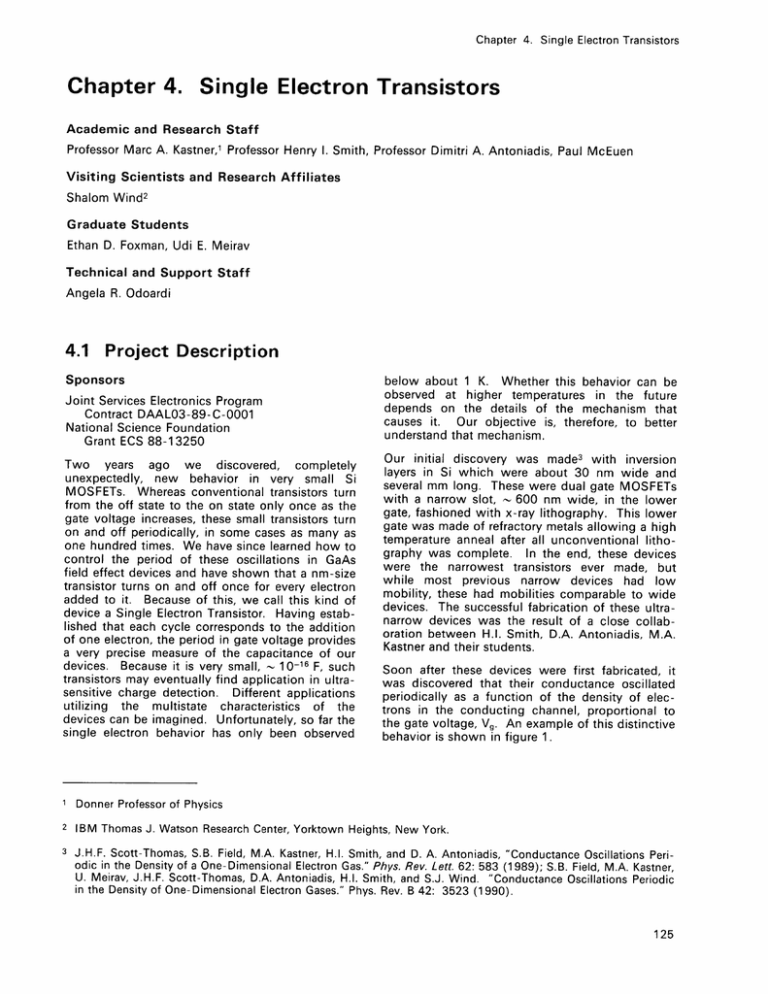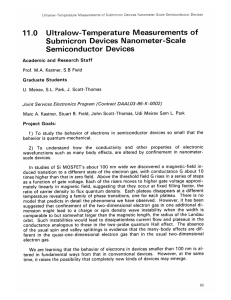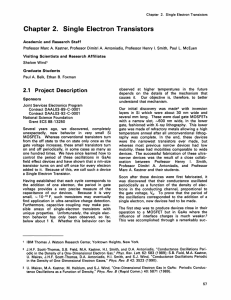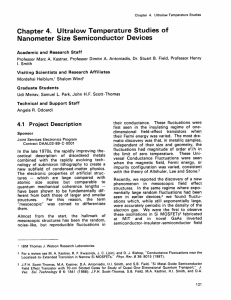Chapter 4. Single Electron Transistors
advertisement

Chapter 4. Single Electron Transistors Chapter 4. Single Electron Transistors Academic and Research Staff Professor Marc A. Kastner,1 Professor Henry I. Smith, Professor Dimitri A. Antoniadis, Paul McEuen Visiting Scientists and Research Affiliates Shalom Wind 2 Graduate Students Ethan D. Foxman, Udi E. Meirav Technical and Support Staff Angela R. Odoardi 4.1 Project Description Sponsors below about 1 K. Whether this behavior can be observed at higher temperatures in the future depends on the details of the mechanism that causes it. Our objective is, therefore, to better understand that mechanism. Joint Services Electronics Program Contract DAAL03-89-C-0001 National Science Foundation Grant ECS 88-13250 Two years ago we discovered, completely unexpectedly, new behavior in very small Si MOSFETs. Whereas conventional transistors turn from the off state to the on state only once as the gate voltage increases, these small transistors turn on and off periodically, in some cases as many as one hundred times. We have since learned how to control the period of these oscillations in GaAs field effect devices and have shown that a nm-size transistor turns on and off once for every electron added to it. Because of this, we call this kind of device a Single Electron Transistor. Having established that each cycle corresponds to the addition of one electron, the period in gate voltage provides a very precise measure of the capacitance of our devices. Because it is very small, _ 10-16 F, such transistors may eventually find application in ultrasensitive charge detection. Different applications utilizing the multistate characteristics of the devices can be imagined. Unfortunately, so far the single electron behavior has only been observed Our initial discovery was made 3 with inversion layers in Si which were about 30 nm wide and several mm long. These were dual gate MOSFETs with a narrow slot, - 600 nm wide, in the lower gate, fashioned with x-ray lithography. This lower gate was made of refractory metals allowing a high temperature anneal after all unconventional lithography was complete. In the end, these devices were the narrowest transistors ever made, but while most previous narrow devices had low mobility, these had mobilities comparable to wide devices. The successful fabrication of these ultranarrow devices was the result of a close collaboration between H.I. Smith, D.A. Antoniadis, M.A. Kastner and their students. Soon after these devices were first fabricated, it was discovered that their conductance oscillated periodically as a function of the density of electrons in the conducting channel, proportional to the gate voltage, V,. An example of this distinctive behavior is shown in figure 1. 1 Donner Professor of Physics 2 IBM Thomas J. Watson Research Center, Yorktown Heights, New York. 3 J.H.F. Scott-Thomas, S.B. Field, M.A. Kastner, H.I. Smith, and D. A. Antoniadis, "Conductance Oscillations Periodic in the Density of a One-Dimensional Electron Gas." Phys. Rev. Lett. 62: 583 (1989); S.B. Field, M.A. Kastner, U. Meirav, J.H.F. Scott-Thomas, D.A. Antoniadis, H.I. Smith, and S.J. Wind. "Conductance Oscillations Periodic in the Density of One-Dimensional Electron Gases." Phys. Rev. B 42: 3523 (1990). 125 Chapter 4. Single Electron Transistors The first step was to produce devices close in their operation to a MOSFET but in GaAs where the4 influence of interface charges is much weaker. This was accomplished through a remarkably successful collaboration with M. Heiblum of IBM. The new structure was created by growing AIGaAs on a conductive substrate, followed by a layer of The electron density at the undoped GaAs. GaAs/AIGaAs interface, inverted from the usual configuration was varied by applying a voltage to the substrate. Heiblum was able to grow such mobilities of with heterojunctions inverted ~ 500,000 cm 2 /V-s. Next, the conducting channel is defined by depositing a metal gate on top of the GaAs, and a gap is patterned in the gate by electron beam lithography. Because a depletion region is created under the gate, the electrons accumulate only under the gap. In order to emulate the effect of two charged impurities, two constrictions are patterned in the gap, as illustrated in figure 2. The electron beam lithography was done at IBM with the help of S. Wind. Figure 1. The foremost problem posed by our discovery was to find out what determined the period of the conductance oscillations. We soon discovered that the period varied at random from device to device, indicating that it was determined by the random spacing of interface charges that happened to fall over the conducting channel. This suggested that potential barriers resulting from the interface charges were isolating a segment of the channel and that the conductance underwent one cycle every time the same number of electrons was added to the isolated segment. To prove this, and to ascertain what that number of electrons was, new devices had to be made. 4 Devices of the kind depicted in figure 2 worked exactly as we hoped they would.5 Periodic oscillations of the conductance were seen again, but now they were controlled: The period was the same for different devices with the same spacing between constrictions and was larger when the spacing was shorter, which is consistent with the idea that the same number of electrons is added for one period in all devices. This is illustrated in figure 3. Calculations of the capacitance of such devices are only consistent with each period corresponding to one electron added per oscillation. This is an amazing result: Figure 3 shows that for the shortest structures the conductance consists of periodic, narrow, well-separated resonances. The conductance rises and falls by a factor - 100 with a variation of gate voltage that corresponds to only - 1/10 of an electron. U. Meirav, M.A. Kastner, M. Heiblum, and S.J. Wind, "One-Dimensional Electron Gas in GaAs: Periodic Conductance Oscillations as a Function of Density," Phys. Rev. B (Rapid Comm.) 40: 5871 (1989). "Single Electron Charging and Periodic Conductance Resonances in GaAs 5 U. Meirav and S. J. Wind, Nanostructures," Phys. Rev. Lett. 65: 771 (1990). 126 RLE Progress Report Number 133 Chapter 4. Single Electron Transistors Figure 2. We are not yet sure what causes the Single Electron Transistor to work the way it does. The conductance appears to result from resonant tunneling, but the nature of the states that are resonant is still unclear. Patrick Lee and his collaborators believe that the states arise from single particle quantum states (the Fabry-Perot states induced by the two barriers, the same as expected for any "quantum dot"), but that the energies of the levels are dominated by the Coulomb interaction between the electrons in the isolated segment. Van Houten and Beenakker argued that the Coulomb interaction alone could explain the phenomena we see, and that the effect was the same as the Coulomb blockade recently popularized by Likharev. Some of our measurements suggest, however, that electron-electron correlation, in addition to the simple Coulomb interaction, may be important. 127 Chapter 4. Single Electron Transistors 12 8 (a) 4 12 T c: O, 8 (b) I- (c) 124 0 44 12 0 4 V 8 - VI (mV) Figure 3. 128 RLE Progress Report Number 133 12




